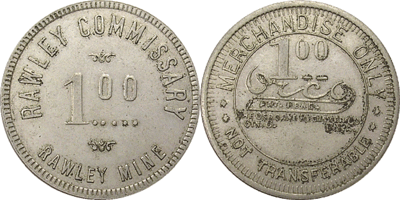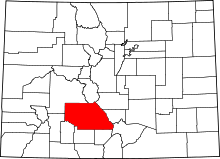Bonanza, Colorado
| Town of Bonanza, Colorado | |
|---|---|
| Statutory Town | |
 Location in Saguache County and the state of Colorado | |
 Town of Bonanza, Colorado Location in the United States | |
| Coordinates: 38°17′48″N 106°08′31″W / 38.296607°N 106.141873°WCoordinates: 38°17′48″N 106°08′31″W / 38.296607°N 106.141873°W[1] | |
| Country |
|
| State |
|
| County | Saguache County[2] |
| Incorporated |
1881-01-13, as the Town of Bonanza City[3] |
| Government | |
| • Type | Statutory Town[2] |
| Area | |
| • Total | 0.4 sq mi (1.1 km2) |
| • Land | 0.4 sq mi (1.1 km2) |
| • Water | 0 sq mi (0 km2) |
| Elevation | 9,478 ft (2,889 m) |
| Population (2010) | |
| • Total | 16 |
| • Density | 40/sq mi (15/km2) |
| Time zone | MST (UTC-7) |
| • Summer (DST) | MDT (UTC-6) |
| ZIP Code | Villa Grove CO 81155[4] |
| INCITS place code | 0807571 |
| GNIS feature ID | 0189929 |
| Highways | none |
|
| |
The Town of Bonanza is a Statutory Town located in Saguache County, Colorado, United States. Formerly known as Bonanza City, Bonanza is a largely abandoned former silver mining town. Bonanza is a Spanish language word meaning prosperity. The town population was 16 at the 2010 United States Census, ranking Bonanza as the second least populous municipality in the State of Colorado.[5] The Villa Grove Post Office (ZIP Code 81155) now serves Bonanza.[4]
History
In 1880, Tom Cooke of Salida, Colorado stumbled upon ore deposits while searching for horses. Prospectors flocked to this location and the town of Bonanza was founded. In the first two years of its existence, its population ballooned to between 1,000 and 1,500. At the time, population of mining towns was determined by the number of saloons and dance halls instead of a census taker and at this time, Bonanza had 36 saloons and 7 dance halls.[6]
Geography
Bonanza is located at 38°17′42″N 106°8′25″W / 38.29500°N 106.14028°W (38.295138, −106.140158)[7] at an altitude of 9500 feet.
According to the United States Census Bureau, the town has a total area of 0.4 square miles (1.0 km2), all of it land.

Demographics
| Historical population | |||
|---|---|---|---|
| Census | Pop. | %± | |
| 1890 | 96 | — | |
| 1900 | 141 | 46.9% | |
| 1910 | 96 | −31.9% | |
| 1920 | 91 | −5.2% | |
| 1930 | 445 | 389.0% | |
| 1940 | 140 | −68.5% | |
| 1950 | 51 | −63.6% | |
| 1960 | 19 | −62.7% | |
| 1970 | 10 | −47.4% | |
| 1980 | 8 | −20.0% | |
| 1990 | 16 | 100.0% | |
| 2000 | 14 | −12.5% | |
| 2010 | 16 | 14.3% | |
| Est. 2015 | 16 | [8] | 0.0% |
As of the census[10] of 2000, there were 14 people, 7 households, and 3 families residing in the town. The population density was 31.9 people per square mile (12.3/km²). There were 33 housing units at an average density of 75.3 per square mile (29.0/km²). The racial makeup of the town was 71.43% White, 7.14% Asian, and 21.43% from two or more races.
There were 7 households out of which 14.3% had children under the age of 18 living with them, 42.9% were married couples living together, and 57.1% were non-families. 42.9% of all households were made up of individuals and none had someone living alone who was 65 years of age or older. The average household size was 2.00 and the average family size was 3.00.
In the town the population was spread out with 7.1% under the age of 18, 28.6% from 18 to 24, 14.3% from 25 to 44, 50.0% from 45 to 64, . The median age was 44 years. For every 100 females there were 180.0 males. For every 100 females age 18 and over, there were 160.0 males.
The median income for a household in the town was $63,750, and the median income for a family was $27,000. Males had a median income of $0 versus $0 for females. The per capita income for the town was $66,857. None of the population and none of the families were below the poverty line.
Media Coverage
An essay about the town written by resident Antonya Nelson appeared in The New York Times on October 27, 2010. The name of the town was not revealed in the essay; it was instead referred to as "Eureka." However, various characteristics of "Eureka" described in the essay, including its status as an incorporated ghost town, historical silver mine, and Superfund site, reveal "Eureka" to be Bonanza. In addition, a photo slide show accompanying the essay features structures also photographed on a website dedicated to the Bonanza ghost town.
See also
References
- ↑ "2014 U.S. Gazetteer Files: Places". United States Census Bureau. July 1, 2014. Retrieved January 5, 2015.
- 1 2 "Active Colorado Municipalities". State of Colorado, Department of Local Affairs. Archived from the original on November 23, 2010. Retrieved 2007-11-30.
- ↑ "Colorado Municipal Incorporations". State of Colorado, Department of Personnel & Administration, Colorado State Archives. December 1, 2004. Retrieved 2007-11-30.
- 1 2 "ZIP Code Lookup". United States Postal Service. Archived from the original (JavaScript/HTML) on September 3, 2007. Retrieved September 4, 2007.
- ↑ "American FactFinder". U.S. Census Bureau. Retrieved March 4, 2011.
- ↑ Bulletin - Colorado Geological Survey. Colorado Geological Survey, Department of Natural Resources, State of Colorado. 1916. pp. 9–10.
- ↑ "US Gazetteer files: 2010, 2000, and 1990". United States Census Bureau. 2011-02-12. Retrieved 2011-04-23.
- ↑ "Annual Estimates of the Resident Population for Incorporated Places: April 1, 2010 to July 1, 2015". Retrieved July 2, 2016.
- ↑ "Census of Population and Housing". Census.gov. Archived from the original on May 11, 2015. Retrieved June 4, 2015.
- ↑ "American FactFinder". United States Census Bureau. Archived from the original on September 11, 2013. Retrieved 2008-01-31.
External links
| Wikimedia Commons has media related to Bonanza, Colorado. |
- Bonanza Colorado Townsite Ghost town
- CDOT map of the Town of Bonanza
- Bonanza: A History of Mining
- Photos by Steve Garufi

